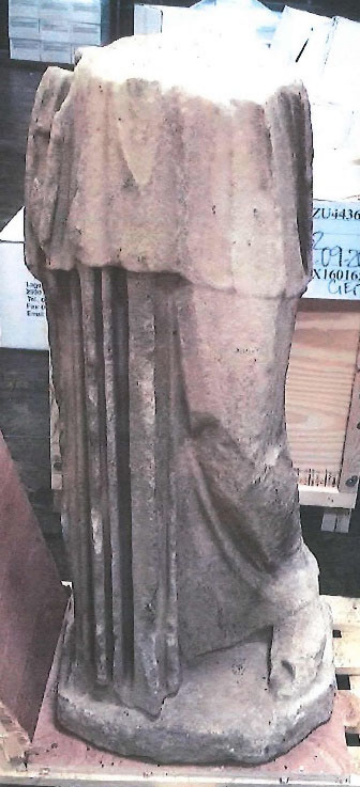Law & Politics
Kim Kardashian Must Forfeit an Ancient Roman Sculpture That Experts Say Was Looted From Italy
The celebrity influencer purchased the work from Axel Vervoordt Gallery in 2016.

The celebrity influencer purchased the work from Axel Vervoordt Gallery in 2016.

Naomi Rea

The U.S. government is seeking the forfeiture of an ancient Roman sculpture that celebrity influencer Kim Kardashian was in the process of acquiring after officials determined that it had been illegally smuggled out of Italy.
The statue was detained at the U.S. border in 2016 after a logistics company working for Kardashian tried to import it with the wrong documentation. New legal documents, first pointed out on Twitter by federal courts reporter Robert Snell and independently verified by Artnet News, have concluded that the work was “looted, smuggled, and illegally exported,” and Italian authorities have requested its repatriation.
A civil forfeiture action on April 30 in a U.S. district court named Kardashian as the consignee and importer of the ancient limestone sculpture. According to court documents, Kardashian bought the sculpture, known as Fragment of Myron’s Samian Athena (1st – 2nd century), in 2016 from Axel Vervoordt Gallery in Belgium. (Vervoordt is the art dealer and interior designer responsible for the decoration of Kardashian’s Calabasas mansion.)
The sculpture was detained when it arrived in Los Angeles in May 2016 after authorities were alerted that it might be protected cultural property. As part of a bilateral agreement to crack down on the pillaging of cultural heritage, the U.S. has restricted imports of archeological material originating from Italy. Any importer now needs clear documentation authorizing the importation or other documents such as an affidavit, license, or permit stating that the export was not in violation of the laws of the country of origin.

A photograph of the antique Roman statue taken by an HSI SA on or about May 11, 2016. Photo courtesy PACER.
The sculpture arrived as part of a 5.5-ton shipment described as containing 40 antiques, Modern furniture, and decorative objects, valued at $745,882. It was being imported under a U.S. tariff schedule for “antiques of an age exceeding 100 years,” as opposed to archeological material.
Officials requested provenance details from the logistics company Masterpiece International, which provided the sculpture’s sales invoice to Kardashian, as well as a previous invoice showing that Vervoordt had purchased the work from Galerie Chenel in Paris in 2012.
Suspicions were raised when authorities noticed a discrepancy in the descriptions of the sculpture on the two invoices, with the 2012 statement describing it as “a large draped statue” with provenance from an “Old German Collection, bought before 1980,” and the invoice for the 2016 sale to Kardashian describing it as a “fragment,” and containing handwritten notations indicating it had originated from Italy. A director from Vervoordt’s art history department, Robert Lauwers, had also provided a contradictory statement by way of an unsworn affidavit stating that the sculpture did not originate from Italy.
The sculpture was seized in June 2016 and, the following month, Italy’s task force for the protection of cultural heritage added a new twist by claiming it had seen (and photographed) the confiscated statue at Vervoordt’s gallery booth at TEFAF Maastricht in 2011, well before Vervoordt purportedly purchased it from Galerie Chenel in 2012.
Ollivier Chenel, a director of Galerie Chenel, told Artnet News that the gallery purchased the sculpture from an auction house in Germany in 2010, and that it had previously come from an English estate. He added that the date discrepancy on the invoice could be explained because the statue had been on loan to Vervoordt before it was officially acquired.
“It is very strange that [the complaint does not mention] the German auction house as the information was given to them at the time,” Chenel said. “I can guarantee you that this sculpture was acquired legally at Hampel Auction house in 2010.”
A spokesperson for Axel Vervoordt told Artnet News that the forfeiture filing took the gallery by surprise. “We have acquired this piece in good faith from a French gallery who had also acquired it in equally good faith from a German auction house,” she said. “The former collector was English but precise traces seem to stop there. However, there is no evidence that this piece was illegally imported from Italy.” She added that the gallery’s American client also acted in good faith when dealing with the work but declined to comment further in the interest of discretion. Representatives for Kim Kardashian did not immediately respond to requests for comment.
The decision to seek definitive forfeiture of the sculpture came after an archeologist from Italy’s Ministry of Cultural Heritage analyzed the work in February 2018 and identified it as a copy of an original Greek sculpture executed during the early to mid-Roman Empire. The expert also linked the sculpture to Italy through comparative scientific and iconographic elements. They noted that it had never been reported as a fortuitous find, nor been subject to a request for an export license from Italy, both of which have been required by law since 1909. Based on this information, the archeologist in the forfeiture report determined that the sculpture was “looted, smuggled, and illegally exported from Italy.”
A spokesperson for the court told Artnet News that the potential claimants involved will have an opportunity to litigate the matter before the court issues a final order of forfeiture. The court may still demand “other and further relief,” as well as the cost of the proceedings.